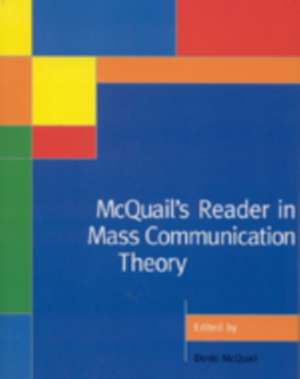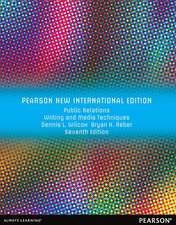McQuail's Reader in Mass Communication Theory
Editat de Denis McQuailen Limba Engleză Paperback – 21 mar 2002
McQuails Reader in Mass Communication Theory includes key statements from;
Pertti Alasuutari
Ien Ang
Jan L. Bordewijk
Jay G. Blumler
Roland Barthes
Oliver Boyd-Barrett
Muriel G. Cantor
James Carey
Peter Dahlgren
Daniel Dayan
Everette E. Dennis
Todd Gitlin
Alvin W. Gouldner
Robert M. Entman
Celia von Feilitzen
Marjorie Ferguson
Edward S. Herman
Terhi Rantanen
Stuart Hall
Joli Jenson
Elihu Katz
Judith Lichtenberg
John H. McManus
Joshua Meyrowitz
C. Wright Mills
Merrill Morris
John C. Nerone
W. R. Neumann
Janice Radway
Ronald E. Rice
Karl Erik Rosengren
James Slevin
Pamela J. Shoemaker
John Tomlinson
Gaye Tuchman
Ellen Wartella
Judith Williamson
Dolf Zillmann
Liesbet van Zoonen
Preț: 617.25 lei
Preț vechi: 801.63 lei
-23% Nou
Puncte Express: 926
Preț estimativ în valută:
118.11€ • 123.57$ • 98.12£
118.11€ • 123.57$ • 98.12£
Carte tipărită la comandă
Livrare economică 02-16 aprilie
Preluare comenzi: 021 569.72.76
Specificații
ISBN-13: 9780761972433
ISBN-10: 0761972439
Pagini: 428
Dimensiuni: 183 x 246 x 25 mm
Greutate: 0.86 kg
Ediția:First Edition
Editura: SAGE Publications
Colecția Sage Publications Ltd
Locul publicării:London, United Kingdom
ISBN-10: 0761972439
Pagini: 428
Dimensiuni: 183 x 246 x 25 mm
Greutate: 0.86 kg
Ediția:First Edition
Editura: SAGE Publications
Colecția Sage Publications Ltd
Locul publicării:London, United Kingdom
Cuprins
PART ONE: ORIGINS AND DEVELOPMENT OF THE FIELD OF STUDY
General Introduction
PART TWO: CONCEPTUAL ISSUES AND VARIETIES OF APPROACH - Denis McQuail
Editor's Introduction
Media Sociology - Todd Gitlin
The Dominant Paradigm
A Cultural Approach to Communication - James W Carey
A `New' Paradigm? - Liesbet van Zoonen
The Propaganda Model - Edward S Herman
A Retrospective
PART THREE: MASS MEDIA AND SOCIETY
Editor's Introduction
The Mass Society - C Wright Mills
The Communications Revolution - Alvin W Gouldner
News, Public, and Ideology
Defining Media Events - Daniel Dayan and Elihu Katz
Media and Behavior - a missing link - Joshua Meyrowiz
PART FOUR: FROM OLD TO NEW MEDIA
Editor's Introduction
Towards a New Classification of Tele-Information Services - Jan L Bordewijk and Ben van Kaam
Artifacts and Paradoxes in New Media - Ronald E Rice
The Internet as Mass Medium - Merrill Morris and Christine Ogan
The Internet and Forms of Human Association - James Slevin
PART FIVE: NORMATIVE THEORY
Editor's Introduction
The Press and the Public Interest - Everette E Dennis
A Definitional Dilemma
Foundations and Limits of Freedom of the Press - Judith Lichtenberg
On Social Responsibility Theory - John C Nerone
The Public Sphere as Historical Narrative - Peter Dalhgren
New Roles for Public Service Television - Jay G Blumler and Wolfgang Hoffmann-Reim
PART SIX: GLOBAL MASS COMMUNICATION
Editor's Introduction
Theorizing the News Agencies - Oliver Boyd-Barrett and Terhi Rantanen
The Discourse of Cultural Imperialism - John Tomlinson
International Communication at the Mass Media Level - Karl Erik Rosengren
The Mythology about Globalization - Marjorie Ferguson
PART SEVEN: MEDIA ORGANIZATION AND PRODUCTION
Editor's Introduction
A New Gatekeeping Model - Pamela J Shoemaker
Making News - Gaye Tuchman
Time and Typifications
Does Serving the Market Conflict with Serving the Public? - John H McManus
The Hollywood TV Producer - Muriel G Cantor
PART EIGHT: MEDIA CONTENT
Editor's Introduction
Rhetoric of the Image - Roland Barthes
Meaning and Ideology - Judith Williamson
The Television Discourse; Encoding and Decoding - Stuart Hall
The Ideal Romance - Janice Radway
PART NINE: THE MEDIA AUDIENCE
Editor's Introduction
Three Phases of Reception Studies - Pertti Alasuutari
Streamlining `Television Audiences' - Ien Ang
Fandom as Pathology - Joli Jenson
The Consequences of Characterization
Needs as an Explanatory Factor of Television Viewing - Celia von Feilitzen
The Future of the Mass Audience - W Russell Neuman
PART TEN: MASS MEDIA EFFECTS
Editor's Introduction
Publicity and Pluralistic Ignorance - Elihu Katz
Notes on the `Spiral of Silence'
Framing - Robert M Entman
Towards Clarification of a Fractured Paradigm
Children and Television Violence in the United States - Ellen Wartella, Adriana Olivarez and Nancy Jennings
Entertainment as Media Effect - Dolf Zillmann and Jennings Bryant
General Introduction
PART TWO: CONCEPTUAL ISSUES AND VARIETIES OF APPROACH - Denis McQuail
Editor's Introduction
Media Sociology - Todd Gitlin
The Dominant Paradigm
A Cultural Approach to Communication - James W Carey
A `New' Paradigm? - Liesbet van Zoonen
The Propaganda Model - Edward S Herman
A Retrospective
PART THREE: MASS MEDIA AND SOCIETY
Editor's Introduction
The Mass Society - C Wright Mills
The Communications Revolution - Alvin W Gouldner
News, Public, and Ideology
Defining Media Events - Daniel Dayan and Elihu Katz
Media and Behavior - a missing link - Joshua Meyrowiz
PART FOUR: FROM OLD TO NEW MEDIA
Editor's Introduction
Towards a New Classification of Tele-Information Services - Jan L Bordewijk and Ben van Kaam
Artifacts and Paradoxes in New Media - Ronald E Rice
The Internet as Mass Medium - Merrill Morris and Christine Ogan
The Internet and Forms of Human Association - James Slevin
PART FIVE: NORMATIVE THEORY
Editor's Introduction
The Press and the Public Interest - Everette E Dennis
A Definitional Dilemma
Foundations and Limits of Freedom of the Press - Judith Lichtenberg
On Social Responsibility Theory - John C Nerone
The Public Sphere as Historical Narrative - Peter Dalhgren
New Roles for Public Service Television - Jay G Blumler and Wolfgang Hoffmann-Reim
PART SIX: GLOBAL MASS COMMUNICATION
Editor's Introduction
Theorizing the News Agencies - Oliver Boyd-Barrett and Terhi Rantanen
The Discourse of Cultural Imperialism - John Tomlinson
International Communication at the Mass Media Level - Karl Erik Rosengren
The Mythology about Globalization - Marjorie Ferguson
PART SEVEN: MEDIA ORGANIZATION AND PRODUCTION
Editor's Introduction
A New Gatekeeping Model - Pamela J Shoemaker
Making News - Gaye Tuchman
Time and Typifications
Does Serving the Market Conflict with Serving the Public? - John H McManus
The Hollywood TV Producer - Muriel G Cantor
PART EIGHT: MEDIA CONTENT
Editor's Introduction
Rhetoric of the Image - Roland Barthes
Meaning and Ideology - Judith Williamson
The Television Discourse; Encoding and Decoding - Stuart Hall
The Ideal Romance - Janice Radway
PART NINE: THE MEDIA AUDIENCE
Editor's Introduction
Three Phases of Reception Studies - Pertti Alasuutari
Streamlining `Television Audiences' - Ien Ang
Fandom as Pathology - Joli Jenson
The Consequences of Characterization
Needs as an Explanatory Factor of Television Viewing - Celia von Feilitzen
The Future of the Mass Audience - W Russell Neuman
PART TEN: MASS MEDIA EFFECTS
Editor's Introduction
Publicity and Pluralistic Ignorance - Elihu Katz
Notes on the `Spiral of Silence'
Framing - Robert M Entman
Towards Clarification of a Fractured Paradigm
Children and Television Violence in the United States - Ellen Wartella, Adriana Olivarez and Nancy Jennings
Entertainment as Media Effect - Dolf Zillmann and Jennings Bryant
Descriere
McQuail's Reader in Mass Communication Theory provides an invaluable resource of key statements from communication studies, media sociology and cultural studies, and includes an overview essay and section introductions. Designed as a companion to Mass Communication Theory, it can also function independently.
















